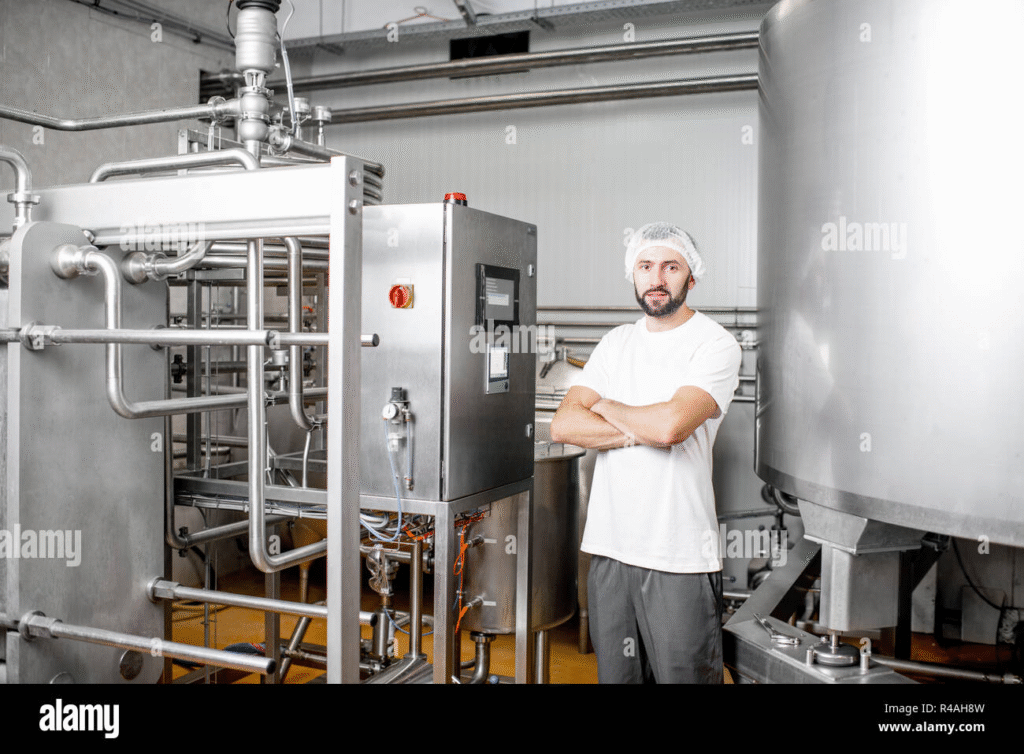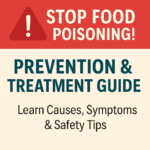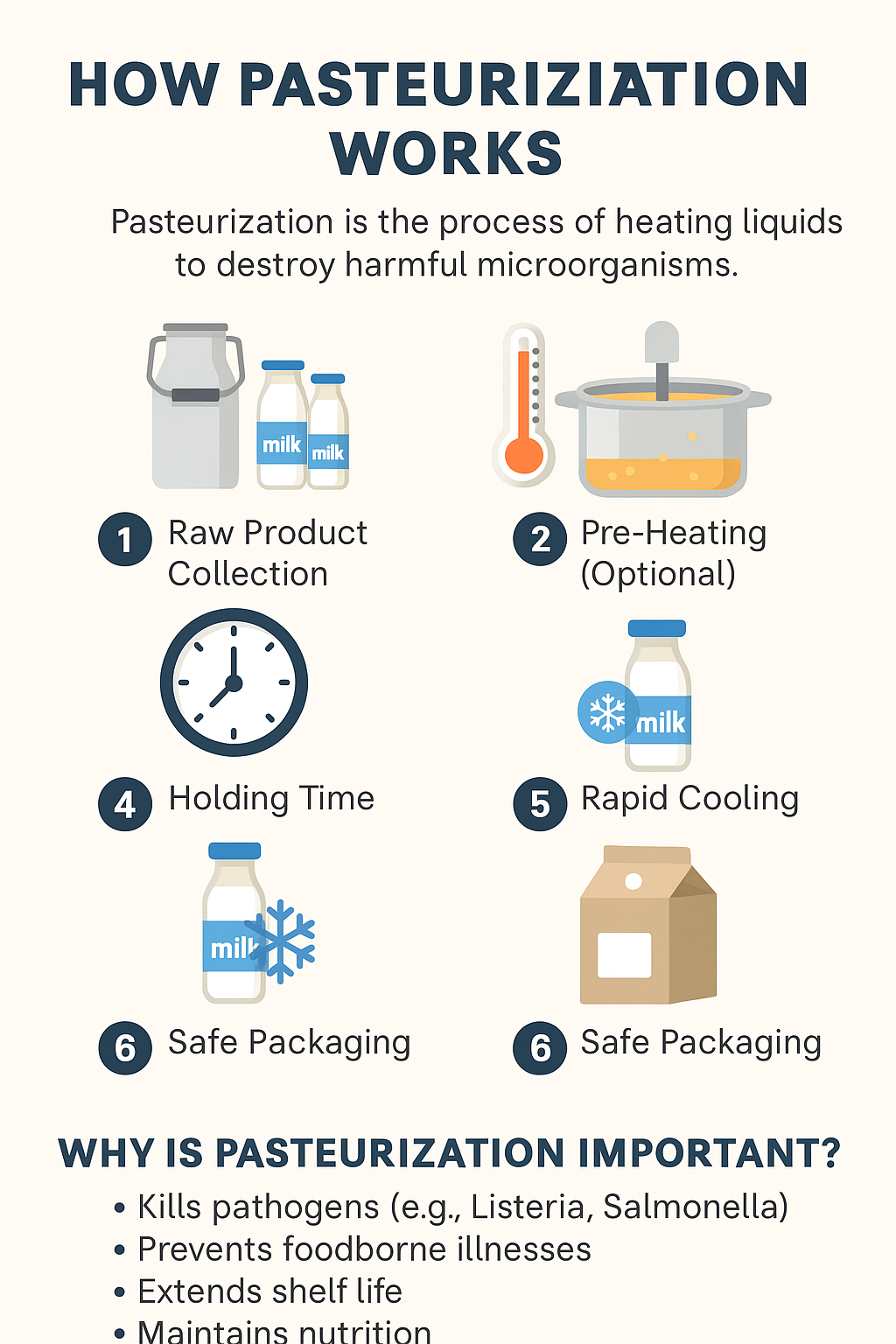Importance of Pasteurization in Dairy Products: A Complete Guide (2025)
Dairy products like milk, cheese, yogurt, and cream are a part of our daily diet. But do you know that raw (unpasteurized) dairy products can harbor harmful bacteria? This is where pasteurization plays a critical role in ensuring the safety of dairy products.
What is Pasteurization?
Pasteurization is a process of heating milk and dairy products to a specific temperature for a set period of time to kill harmful microorganisms like bacteria, viruses, molds, and yeasts without affecting the nutritional value.
The technique was invented by Louis Pasteur in the 19th century and is now widely used to make food and beverages safe for consumption.
Why is Pasteurization Important in Dairy Products?
1. Kills Harmful Pathogens
- Reduces risk of illness: Pasteurization kills bacteria like Salmonella, E. coli, and Listeria that can cause serious illnesses.
- Protects vulnerable populations: Pasteurization is especially important for vulnerable populations like the elderly, young children, and people with weakened immune systems.
Other Benefits
- Extends shelf life: Pasteurization extends the shelf life of dairy products by reducing bacterial growth.
- Ensures food safety: Pasteurization ensures the safety of dairy products by reducing the risk of contamination.
Importance in Dairy Products
- Milk: Pasteurization is crucial for milk to prevent the spread of diseases.
- Cheese: Pasteurization is important for soft cheeses and other dairy products that are more susceptible to contamination.
- Other dairy products: Pasteurization is also important for other dairy products like yogurt and ice cream.
These pathogens can cause severe illnesses including food poisoning, typhoid, tuberculosis, and listeriosis. Pasteurization effectively eliminates these microbes.
2. Prevents Foodborne Diseases
Pasteurization reduces the risk of diseases that spread through contaminated dairy products such as:
- Gastroenteritis
- Typhoid fever
- Brucellosis
- Tuberculosis (from bovine TB)
3. Extends Shelf Life of Dairy Products
By destroying spoilage organisms, pasteurization helps extend the shelf life of milk, curd, cheese, and other dairy items without compromising their taste and nutritional value.
4. Ensures Nutritional Safety
Pasteurized milk retains essential nutrients like:
- Calcium
- Vitamin D
- Proteins
- Phosphorus
It ensures that consumers get safe and nutrient-rich dairy products.
5. Protects High-Risk Groups
Pasteurization is especially important for:
- Pregnant women
- Infants
- Elderly individuals
- People with weak immune systems
For these groups, consuming unpasteurized milk can lead to life-threatening infections.

**********************************************************************************
Common Methods of Pasteurization in Dairy Products
Pasteurization is a process that kills harmful bacteria and extends the shelf life of dairy products. Here are some common methods of pasteurization:
Methods of Pasteurization
- High Temperature Short Time (HTST): This method involves heating milk to 161°F (72°C) for at least 15 seconds.
- Extended Shelf Life (ESL): This method involves heating milk to 194°F (90°C) for 2-5 seconds.
- Ultra-High Temperature (UHT): This method involves heating milk to 280°F (138°C) for 2 seconds.
- Batch Pasteurization: This method involves heating milk to 145°F (63°C) for 30 minutes.
Benefits of Pasteurization
- Kills harmful bacteria: Pasteurization kills bacteria like Salmonella, E. coli, and Listeria that can cause illness.
- Extends shelf life: Pasteurization extends the shelf life of dairy products by reducing bacterial growth.
- Improves food safety: Pasteurization improves food safety by reducing the risk of foodborne illness.
Types of Dairy Products
- Milk: Pasteurization is commonly used for milk to kill bacteria and extend shelf life.
- Cheese: Some types of cheese, like soft cheeses, may be pasteurized to reduce the risk of foodborne illness.
- Yogurt: Yogurt is often made from pasteurized milk to ensure safety and quality.
Pasteurization is an important step in ensuring the safety and quality of dairy products.

**********************************************************************************
Health Benefits of Pasteurized Dairy Products
| Benefit | Explanation |
|---|---|
| Food Safety | Eliminates harmful bacteria and pathogens |
| Longer Shelf Life | Keeps dairy products fresh for longer periods |
| Nutritional Integrity | Retains essential vitamins and minerals |
| Prevents Serious Diseases | Reduces risk of milk-borne illnesses |
| Suitable for All Age Groups | Safe for babies, elderly, and immunocompromised |
Unpasteurized vs Pasteurized Dairy Products
| Aspect | Unpasteurized | Pasteurized |
|---|---|---|
| Safety | High risk of contamination | Safe to consume |
| Shelf Life | Short | Extended |
| Taste | Slightly different, fresh | Slightly cooked flavor |
| Health Risk | Can cause infections | Minimizes health risks |
Pasteurization: A Legal Requirement in Many Countries
In most countries, including the United States, European Union, and India, pasteurization of dairy products is legally mandated to protect public health. Selling raw milk without pasteurization is either restricted or strictly regulated.
Is Pasteurized Milk Less Nutritious?
No, pasteurization has minimal impact on milk’s nutritional value. While there may be slight reductions in certain enzymes and vitamins (like Vitamin C), the overall benefits of safe consumption far outweigh these minor losses.

Frequently Asked Questions (FAQs)
Q1. Can pasteurization kill all bacteria?
Pasteurization kills most harmful bacteria but may not destroy certain heat-resistant spores. However, these spores typically do not grow in refrigerated conditions.
Q2. Is boiling the same as pasteurization?
Boiling milk (100°C) is not the same as pasteurization. Pasteurization uses controlled temperatures (63-135°C) for specific times to balance safety and nutritional preservation.
Q3. Can I drink unpasteurized milk if it’s from a trusted farm?
Even if the source is trusted, raw milk can still contain harmful pathogens. Pasteurization is essential for safe consumption.
Q4. Does pasteurized milk taste different?
There may be a slight difference in taste, but most consumers do not notice significant changes. Ultra-pasteurized milk might have a more “cooked” flavor.
Q5. Is pasteurization only for milk?
No, pasteurization is also applied to other dairy products like cheese, cream, yogurt, butter, and even non-dairy items like juices and wines.
Conclusion
Pasteurization is a crucial process in ensuring the safety, quality, and longevity of dairy products. It protects consumers from serious illnesses, preserves nutritional value, and promotes public health. By understanding the importance of pasteurization, we can make safer choices when buying and consuming dairy products.
*********************************************************************************
https://dairyprocessinghandbook.tetrapak.com/chapter/pasteurized-and-esl-dairy-products
https://pram123.com/your-refrigerator-listeria-free-essential-safe-kitchen/
********************************************************************************
Table of Contents
Pasteurization in Dairy Products Pasteurization in Dairy Products Pasteurization in Dairy Products Pasteurization in Dairy Products Pasteurization in Dairy Products Pasteurization in Dairy Products Pasteurization in Dairy Products Pasteurization in Dairy Products











